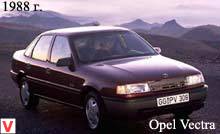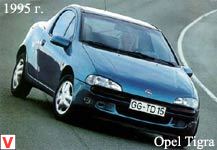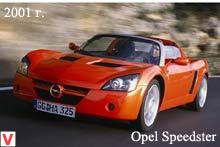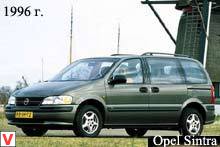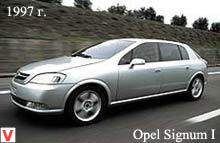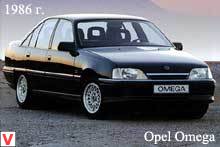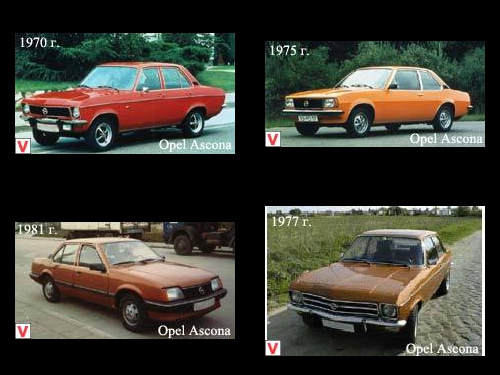
Initially, Ascona was supposed to be produced as Kadett C, and the first prototypes were made in this form. At the same time, the head of Opel Bob Lutz proposed to create a new model range. This is how the independent Ascona lineup came into being. The car of the first generation with the index "A" was produced in three types of body - 2-door sedan, 4-door sedan, and station wagon.
Also on the basis of the 4-door sedan produced a special police car. The rear-wheel drive Ascona was equipped with 12S / 16N, 16S, 19S, 19E-US engines with a carburetor or an electronic injector, and a four-speed manual or three-speed automatic gearbox. The second generation appeared in 1975 and received the index "B". Appearance had many similar features with the model of the first generation.
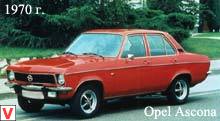
The classic layout has been preserved: the engine is in front, the rear wheels are leading. Suspension comfortable and durable, independent in front, dependent on the back - the bridge. In 1981, the Ascona C, built on a new General Motors platform called J-Car, was released. This generation had little to do with the previous one and surpasses it in many ways. Thanks to the transverse arrangement of the engine, the cabin has become more spacious and comfortable. Ascona C was produced with a 2- or 4-door sedan type body or with a 5-door hatchback body.
To increase the body's resistance to corrosion, Opel specialists made thresholds, doors and trunk lid of galvanized sheet. Constant high demand for the model was ensured due to a fairly practical and reliable design, as well as a wide range of carburetor engines with a gas-distributing mechanism such as OHC with hydraulic pushers. The range of engines consisted of four carburetor: 1.3 l N / 60 l. s., 1.3 l S / 75 l. s., 1.6 l N / 75 l.
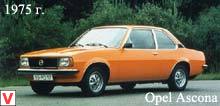
s., 1.6 l S / 82 l. from. The maximum speed of Ascona is from 140 to 180 km / h. Many of these power units are borrowed from the Opel Kadett. Engines are aggregated with a 4-speed manual gearbox. Instead, on request it was possible to install a 3-speed automatic (on any engine, except 13N). Four versions were produced: Standard, Luxus, Berlina, and SR sports car. Salon featured a simple and functional finish.
The original dashboard went into the console. The tachometer was installed only starting with the execution of GL. "Janitor" and the washer on the back door of the hatchback also set starting with version GL. But the most expensive version of the SR / SRi, in addition to the electropackage and the “janitors” of the headlights, was also equipped with sports seats and the Recaro three-spoke steering wheel. The front suspension is a traditional McPherson with rigid lower arms and a stabilizer bar, and the rear is semi-independent with two trailing arms connected to a continuous bridge by a torsion beam and shortened springs of variable cross section.

In 1982, a number of power units replenished diesel 1.6 liters D / 55 liters. s., injection 1.8 liter LE / 115 l. from. with the injection system LE-Jetronic and 5-speed manual gearbox. For an additional fee, it became possible to install power steering, electric windows, electric mirrors and on-board computer. In 1982, the Ascona became the best-selling middle-class car in Germany. 1983 was marked by the emergence of options such as central locking and heated rear-view mirrors. On the SR model with the 1.8 liter LE engine, sports shock absorbers began to be installed.
Rear brakes equipped with an automatic power supply system. In 1984, conduct the first face lifting. It was decided to change the name of a complete set of Ascona. The basic version was called LS, Luxus - GL, Berlina - GLS, SR - GT. All models began to be equipped with a GT radiator lining with large caps, adjustable seats, an improved dashboard, and internal mirror adjustment.
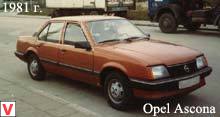
A height-adjustable steering column and a start-stop system for the 1.3 S engine appeared. Changes in the design of the clutch and optical elements. In 1985, the injection engine 1.8i appeared with a three-way catalyst. In 1986 passes the second face lifting.
Headlights and taillights have taken other forms. The radiator grille, ventilation grilles and front spoiler began painting in the color of the car. In 1987, new engines appeared: 1.6i with a three-way catalyst and a Multec mono-injector (75 hp), and 2.0i with a three-way catalyst and a Bosh Motronic injector (115 hp, without a catalyst 130 hp). Ascona C at one time enjoyed great success in almost all European countries. In August 1988, the production of Opel Ascona, it was decided to stop.
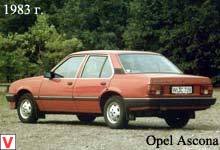
Other images auto Opel Ascona


